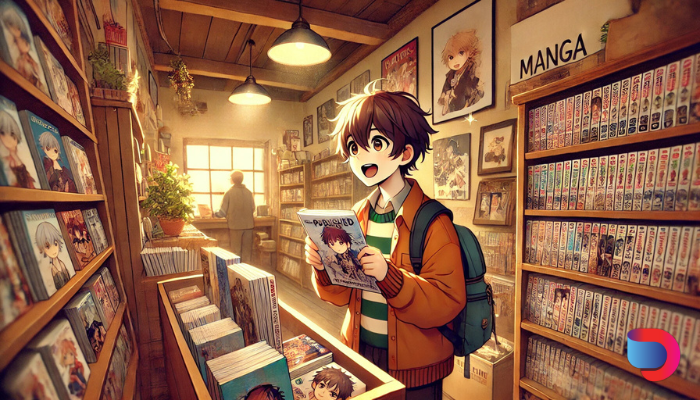What is Doujinshi? Discovering Self-Published Manga
Explore the vibrant world of doujinshi in manga and anime culture, from self-published gems to events connecting creators and fans.

What if your favorite characters could embark on entirely new adventures, exploring stories you never imagined? This defines the world of doujinshi! It is a playground for artists and fans, exhibiting a fusion of imagination and passion.
The scene is like a bustling marketplace filled with creative minds, each crafting stories and illustrations that resonate with countless fans. This vibrant collection of self-published works reflects the community's creativity and passion for the medium.
So, let’s dive into the fascinating universe of doujinshi, exploring its definition, historical context, modern scene, genres, technological advancements, and legal intricacies.
What is Doujinshi?
At its core, doujinshi refers to self-published works encompassing various formats, including magazines, manga, and novels. These creations, often crafted by individuals or groups, provide artists with the freedom to express their ideas without the limitations of traditional publishing.
- A Blend of Inspiration and Originality: While many of these works draw inspiration from popular series, they also feature original stories. This combination of familiarity and innovation captivates readers, offering fresh perspectives on beloved characters or entirely new narratives.
- A Diverse Community: This realm welcomes both amateurs and seasoned professionals. This diversity fosters a rich community where aspiring artists can learn from established creators, promoting growth and shared experiences.
- The Power of Circles: Within this community, groups of artists often form ‘sākuru’ (circles). These circles act as collaborative hubs where members share resources, ideas, and enthusiasm. Whether they're organizing events or exchanging art techniques, these circles are vital to the doujinshi ecosystem.
In essence, whether diving into a parody or an original tale, the spirit of self-published works thrives on exploration and experimentation.
Also Read: How to Create a Comic Book: Unleash Your Inner Artist
A Brief History of Doujinshi
Self-publishing has a rich history shaped by societal shifts and technological advancements. Understanding its evolution gives us insight into how this practice became an integral part of manga and anime culture.
Early Beginnings and Influences
To understand the evolution, we must look back at its origins. The first self-published magazine, Meiroku Zasshi, emerged in 1874, marking a significant milestone.
Just over a decade later, Garakuta Bunko (1885) followed, further paving the way for self-publishing. These early ventures laid the groundwork for what would become a thriving culture of independent creators.
Growth in the Mid-20th Century
The early Shōwa period saw a surge in the popularity of doujinshi, but the postwar era brought challenges. Although the scene experienced a decline, the foundation for future growth was already established.
This era highlighted the resilience of self-published artists, setting the stage for its revival in the following decades.
The Impact of the 1970s
The 1970s marked a turning point in the history of self-publishing, thanks to advancements in photocopying technology. This innovation made it easier for creators to publish their works, dramatically increasing the number of self-published titles.
This led to a significant increase in artists self-publishing their works more than ever.
The resilience and adaptability of this community highlight its enduring significance. From early publications to modern innovations, it continues to thrive as a creative outlet for artists.
The Current Doujinshi Scene
The modern doujinshi scene is a dynamic blend of creativity and fan engagement. Shifts in themes and major events like Comiket provide a platform for diverse voices in the community.
1980s Shift to Parody Series
The 1980s brought about a notable shift, with parody series (known as aniparo) gaining immense popularity. These humorous takes on existing works allowed creators to showcase their unique interpretations while entertaining readers.
It was a golden age for creativity, where laughter and wit thrived in the pages of self-published works. Two standout series from this era were Urusei Yatsura and Captain Tsubasa.
These beloved franchises not only fueled the growth of doujinshi but also demonstrated the diverse interests within the community.
The Role of Comiket
No discussion of self-publishing would be complete without mentioning Comiket, Japan's largest and most renowned doujinshi event. Established in 1975, this biannual gathering in Tokyo has become a mecca for creators and fans alike.
With thousands of circles showcasing their works, Comiket provides a unique platform for artists to connect with their audience, making it a cornerstone of the modern scene.
What emerged in the 1980s continues to thrive today, with parody works and major conventions fueling a culture where creators can freely explore and share their unique interpretations.
Genres and Themes in Doujinshi
The world of self-published works offers an open canvas for creators to dive into countless genres and themes, showcasing the limitless potential of fan-made works. This variety makes it appealing to readers from all walks of life.
Original Works vs. Parodies
The world of doujinshi encompasses various genres and themes, ranging from original stories to clever parodies. This diversity allows readers to explore different facets of their favorite characters and narratives, keeping the experience fresh and exciting. Whether you’re looking for something familiar or entirely new, there’s a captivating story waiting for you.
Popular Genres: Yaoi, Yuri, Hentai, and More
Several genres stand out in doujinshi, with yaoi (boys' love), yuri (girls' love), furry/kemono, and hentai (adult-themed) among the most popular. Each genre has its dedicated fan base, contributing to the vibrant array of stories that reflect the wide-ranging interests of the community.
Exploring Different Themes
Beyond the mainstream genres, doujinshi also explores various themes, including critique, gag humor, honobono (heartwarming), and serious narratives. This broad spectrum allows artists to address complex issues while engaging their audience through humor and warmth. The versatility ensures that there’s something for everyone, regardless of their preferences.
Also Read: Best Yuri Manga Recommendations for Newbies
The richness of doujinshi lies in its ability to blend different genres and themes. It invites fans to explore narratives that range from light-hearted fun to deeper, more thought-provoking stories. There's always something new to discover.
Also Read: Best Yaoi Manga of All Time
Understanding the Legal Context and Issues
Navigating the legality of doujinshi can be complex. Generally, it is not prosecutable unless a complaint is lodged. This legal ambiguity has led to debates surrounding intellectual property ownership and creators' rights. While many creators operate within this grey area, staying informed about the legal implications of self-publishing is essential.
Several notable cases have highlighted the legal challenges facing doujinshi creators. One significant judgment of the Intellectual Property High Court in 2020 stands out. The High Court made a website pay the doujinshi creator a hefty sum for publishing their work without permission.
It brought attention to the rights of independent artists, emphasizing the need for clarity in the legal framework surrounding self-publishing. The cases concerning doujinshi often underscore the ongoing struggle for creators to balance their passion with the realities of intellectual property rights.
Final Thoughts
Doujinshi is a significant and dynamic part of manga and anime culture. From its roots in self-publishing to its evolution into a thriving community of creators, this practice has captured the hearts of fans worldwide.
The wide range of genres and themes available ensures that there’s something for everyone, while the important role it plays in both amateur and professional publishing cannot be overstated.
So, whether you're diving into a heartwarming yaoi tale or chuckling at a clever parody, remember that doujinshi embodies the spirit of creativity and passion that defines the manga and anime world.
Ready to support the next wave of talented doujinshi artists? Head over to Dashtoon, where you can discover even more fantastic stories and unleash your creativity!
FAQs
Q. What is the difference between doujinshi and traditional manga?
A. Doujinshi is typically self-published and can include original works or derivative content, while established publishers produce traditional manga and often adhere to specific editorial standards.
Q. How can I get started with creating my own doujinshi?
A. In order to do this, begin by brainstorming your story idea and characters. Then, gather your materials, whether digital or traditional, and start sketching and writing. Joining online communities like Dashtoon discord community or local groups can also provide valuable support and feedback.
Q. Are there any famous doujinshi artists I should know about?
A. Yes! Many renowned artists, such as Nakatani Nio, known for Bloom Into You, and Nekotofu, who gained recognition for Oniichan wa Oshimai!, began as doujinshi artists.
Q. What types of themes are commonly explored in doujinshi?
A. It can cover multiple themes, from romance and humor to darker narratives and social commentary. This diversity allows creators to express their unique perspectives and connect with various audiences.
Q. How can I legally support doujinshi creators?
A. Supporting creators can be done by purchasing their works, attending events where they sell their creations, or promoting their work on social media. Engaging with them directly can also foster a supportive community.
Q. Can I sell my doujinshi online?
A. Yes! Many creators do so through platforms like Dashtoon, Etsy, Gumroad, or dedicated sites. Just ensure you’re aware of any legal considerations regarding copyright and intellectual property if your work is derivative.
Q. How can Dashtoon help me in my doujinshi journey?
A. Dashtoon offers a user-friendly platform for aspiring artists to create and share their doujinshi. With tools for digital art creation and resources to publish your work, Dashtoon supports your creative process from start to finish.
